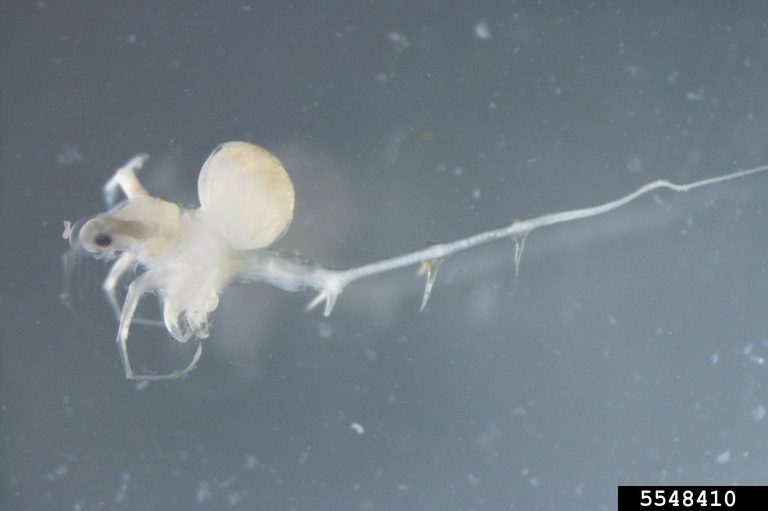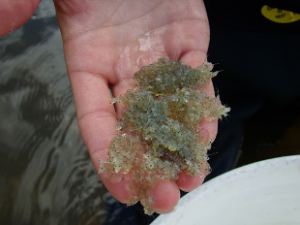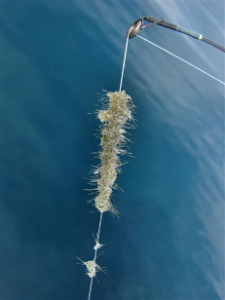Spiny Waterflea (Bythotrephes longimanus)
French common name: Cladocère épineux

Photo: Gary Montz, Bugwood.org

Photo: Invading Species Awareness Program

Spiny waterflea caught on fishing line.
Order: Cladocera
Suborder: Onychopoda
Family: Cercopagididae
Did you know?
Spiny waterfleas form large, jelly-like masses that can spread to other waterbodies on commercial and recreational fishing equipment.
Spiny waterflea is an invasive zooplankton (tiny organisms that travel by wind and water currents) that originated from Eurasia. This invasive species outcompetes native species for food, which can have cascading impacts to the entire food web.
Spiny waterflea was first reported in North America in 1982 in Lake Ontario, having made its way into the Great Lakes through the ballast water of ocean liners traveling from Asia and Europe. Today, spiny waterflea is present in all five Great Lakes and over 100 nearby inland lakes in Ontario and several U.S. states. Researchers are currently studying the threat of spiny waterflea to the diversity and abundance of native zooplankton found in the Great Lakes region (https://www.cabi.org/isc/datasheet/120606#tosummaryOfInvasiveness).
Spiny waterfleas have a single large black eye with a branching antenna that is used to propel them through water. Their abdomen contains four pairs of legs and they have an egg pouch located on the dorsal (top) side of the abdomen (http://www.invadingspecies.com/spiny-and-fishhook-waterfleas/). Spiny waterfleas are just visible with the naked eye at approximately 1.5 cm in length. This species has 1-3 paired barbs on its tail spine, which are used as a defence mechanism to deter predation by small fish (https://tucanada.org/stop-the-spread-spiny-water-flea/). Their tail is slightly angled and makes up 60% of the total body length. Spiny waterfleas can appear orange, blue, or green in colour with a stripe of red running halfway down the length of the tail (http://www.invadingspecies.com/spiny-and-fishhook-waterfleas/).

Photo: http://www.invadingspecies.com/spiny-and-fishhook-waterfleas/
Spiny waterfleas reproduce both sexually and asexually; waterfleas with kinked spines reproduce asexually, while waterfleas with straight spines reproduce sexually (https://tucanada.org/stop-the-spread-spiny-water-flea/). Sexual reproduction occurs in the fall, when female spiny waterfleas produce eggs inside the dorsal egg pouch. The eggs are released and settle to the bottom of the lake, where they remain dormant over the winter until temperatures rise above 4°C. In addition to withstanding winter temperatures, dormant eggs can survive traveling through the digestive tracts of fish without harm (https://tucanada.org/stop-the-spread-spiny-water-flea/)! Asexual females reproduce during the spring, summer, and fall, producing approximately 10 offspring every two weeks. The dorsal egg pouch inflates as embryos develop and emerge as free-swimming juveniles (Alwes and Scholtz, 2014).
Spiny waterfleas live in waters with salinity values (water salt content) between 0.04 – 8.0% and water temperatures between 4 – 30°C (Grigorovich et al., 1998). During the day, they move towards deeper waters to hide from predators. At night, they feed on zooplankton found in shallow waters (https://www.maisrc.umn.edu/about-spinywaterflea).

Photo: https://vtfishandwildlife.com/learn-more/landowner-resources/liep-invasive-species-program/aquatic-invasive-animals/spiny-waterflea
Spiny waterfleas can go unnoticed for a long period of time after introduction because they are so small. Waterbodies that have been infested will contain jelly-like globs of spiny waterfleas with black dots and bristles (eyes and spines) that get caught on fishing line and other fishing equipment (https://www.lakegeorgeassociation.org/educate/science/lake-george-invasive-species/spiny-water-flea/).

Spiny waterflea is native to Eurasia. Populations are found in both the United States and Canada. Spiny waterflea was first detected in 1982 in Lake Ontario. Within a few years, it had spread to Lakes Huron and Erie. Today, spiny waterflea can be found in all five of the Great Lakes and more than 100 other inland waterbodies in Ontario. Lake Winnipeg in Manitoba and several inland U.S. waterbodies surrounding the Great Lakes have also reported the presence of spiny waterflea. The spiny waterflea has also moved out of its native range into other countries in Europe (https://www.cabi.org/isc/datasheet/120606#tosummaryOfInvasiveness).
The map below is the EDDMapS (Early Detection & Distribution Mapping System) Ontario distribution map for the spiny waterflea as of August 2020. To see the current EDDMapS distribution map, click on the map below.
EDDMapS. 2020. Early Detection & Distribution Mapping System. The University of Georgia – Center for Invasive Species and Ecosystem Health. Available online at http://www.eddmaps.org/
Ecological Impacts
Research suggests that the spiny waterflea poses a threat to the biodiversity of native zooplankton communities found within the Canadian Shield (http://www.invadingspecies.com/spiny-and-fishhook-waterfleas/). Because spiny waterfleas consume zooplankton, the structure and abundance of native zooplankton communities are at risk (Yan and Pawson, 1997; Boudreau and Yan, 2003). In area where spiny waterflea is present, native zooplankton species have shown a 30-40% decline (http://www.invadingspecies.com/spiny-and-fishhook-waterfleas/). The spiny waterflea also affects other trophic levels, such as fish species that consume zooplankton (bass, walleye, and yellow perch), by reducing their food supply (Foster and Sprules, 2009). The health of fish species is also a concern in areas invaded by spiny waterflea, as consumption of spiny waterfleas and their spine tails can cause harm (Compton and Kerfoot, 2004).
Economic & Social Impacts
The spiny waterflea is affecting recreational and commercial fishing by getting caught in fishing equipment and commercial netting and trawling lines (https://www.cabi.org/isc/datasheet/120606#tosummaryOfInvasiveness). Jelly-like masses of spiny waterfleas make it difficult to reel in lines, nets, and trawl lines (https://www.ontario.ca/page/spiny-and-fishhook-water-flea). In the U.S., the damage to the ecosystem caused by spiny waterflea has been estimated to cost US$86.5 million–US$163 million to restore (Walsh et al., 2016).

Photo: https://www.seagrant.wisc.edu/our-work/focus-areas/ais/invasive-species/invasive-species-fact-sheets/zooplankton-crayfish/spiny-waterflea/
Manage
There are currently no eradication or control methods for spiny waterflea (https://www.lakegeorgeassociation.org/educate/science/lake-george-invasive-species/spiny-water-flea/). Therefore, preventative activities are critical in stopping the spread of this invasive species into other waterbodies.
- Clean, drain, and dry your boat and fishing equipment: Pressure wash everything on high (250 psi) with hot water (50°C) for 10 minutes and allow five days of drying time before moving to a new waterbody (USGS NAS, 2015).
- Don’t dump your bait! Empty bait buckets away from the waterbody on dry land at least 30 metres from the shoreline (https://www.cabi.org/isc/datasheet/120606#tosummaryOfInvasiveness)
- Spread the word! Increasing public awareness about this invasive species and how to identify it will help to prevent the spread ((http://www.invadingspecies.com/spiny-and-fishhook-waterfleas/).

Photo: https://www.whitelakeadk.com/invasive-species
By Learning how to identify and prevent accidentally spreading this aquatic invasive species, we can protect our lakes! If you see spiny waterflea, report your sightings!
Walsh, J.R., Carpenter, S.R., Vander Zanden, M. J. (2016). Invasive species triggers a massive loss of ecosystem services through a trophic cascade. PNAS Early Edition. Retrieved from https://www.pnas.org/content/pnas/early/2016/03/16/1600366113.full.pdf
Grigorovich, I.A., Pashkova, O.V., Gromova, Y., Van Overdijk, C.D.A., (1998). Bythotrephes longimanus in the Commonwealth of Independent States: variability, distribution and ecology. Hydrobiologia, 379(1-3):183-198. DOI: 10.1023/A:1003427117034
Alwes, F., Scholtz, G. (2014). The early development of the onychopod cladoceran Bythotrephes longimanus (Crustacea, Branchiopoda). Frontiers in Zoology, 11(10):2-22. DOI: https://doi.org/10.1186/1742-9994-11-10
Boudreau, S. A., Yan, N.D. (2003). The differing crustacean zooplankton communities of Canadian Shield lakes with and without the nonindigenous zooplanktivore Bythotrephes longimanus. Canadian Journal of Fisheries and Aquatic Sciences, 60(11):1307-1313. DOI: https://doi.org/10.1139/f03-111
USGS NAS, 2015. USGS Nonindigenous Aquatic Species Database. Gainesville, Florida, USA: USGS. http://nas.er.usgs.gov/
https://www.maisrc.umn.edu/about-spinywaterflea
https://tucanada.org/stop-the-spread-spiny-water-flea/
http://www.invadingspecies.com/spiny-and-fishhook-waterfleas/
https://www.cabi.org/isc/datasheet/120606#tosummaryOfInvasiveness
https://www.lakegeorgeassociation.org/educate/science/lake-george-invasive-species/spiny-water-flea/
Fact Sheets

Add Your Heading Text Here





Add Your Heading Text Here





Add Your Heading Text Here
Best Management Practices





Lorem ipsum dolor sit amet, consectetur adipiscing elit. Ut elit tellus, luctus nec ullamcorper mattis, pulvinar dapibus leo.
Articles
Lorem ipsum dolor sit amet, consectetur adipiscing elit. Ut elit tellus, luctus nec ullamcorper mattis, pulvinar dapibus leo.
Current Research and Knowledge Gaps
Lorem ipsum dolor sit amet, consectetur adipiscing elit. Ut elit tellus, luctus nec ullamcorper mattis, pulvinar dapibus leo.
Further Reading
The Invasive Species Centre aims to connect stakeholders. The following information below link to resources that have been created by external organizations.

